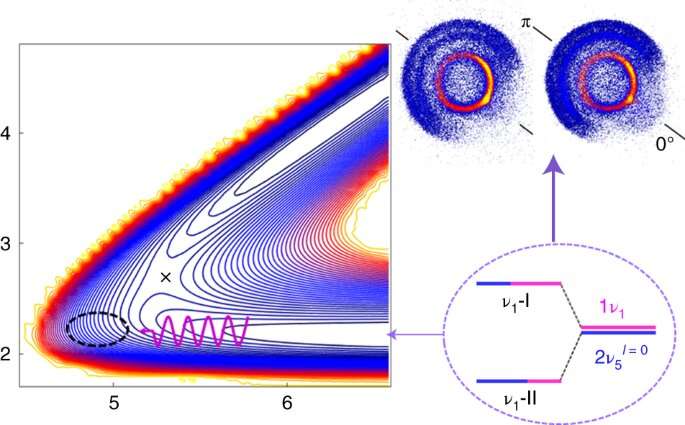Graphical abstract. Credit: Nature Chemistry (2022). DOI: 10.1038/s41557-022-00914-3
A pair of researchers, one with the Southern University of Science and Technology, the other the Institute of Atomic and Molecular Sciences, has developed a means for using quantum vibration properties between molecules to speed up reactions between compounds. In their paper published in the journal Nature Chemistry, Huilin Pan and Kopin Liu describe how they used vibrations in certain types of methane molecules to speed up a reaction during mixing with chlorine using "quantum phase control."
Prior research has shown that vibrations in molecules can control how they react when mixed with one another. In this new effort, the researchers found a way to extend this principle by using some of the properties of vibrations at the quantum level—specifically, Fermi-coupled vibrations. Their goal was to learn more about how a wave function's phase would affect the reactivity between molecules when Fermi-coupled vibrations were involved. They are described as the resonance that occurs when there is a shift of intensities and energies during the absorption of bands in a Raman spectrum. They arise due to wavefunction mixing.
The researchers knew that in order to achieve their goal, they would have to overcome the problem of phase information getting scrambled due to the strong interactions. That led them to using velocity map imaging with time-slicing capabilities. They used a laser to excite deuterated methane molecules in a vacuum chamber and sent the results to another chamber filled with chlorine atoms. As the molecules collided, hydrogen chloride formed along with deuterated methyl radicals. The measuring devices attached to the chambers were strong enough to measure the vibrational states of the molecules, which allowed the researchers to observe phase effects. They found the degree of reactivity in the Fermi-coupled molecules tripled compared to those without such coupling.
The researchers note that the degree of reaction speed was greater than theory suggested because it did not take into consideration the wave function's quantum phase. They suggest their work expands the idea of using vibrational control of reactions into the realm of quantum mechanics.
More information: Huilin Pan et al, Fermi-phase-induced interference in the reaction between Cl and vibrationally excited CH3D, Nature Chemistry (2022). DOI: 10.1038/s41557-022-00914-3
Journal information: Nature Chemistry
© 2022 Science X Network
























